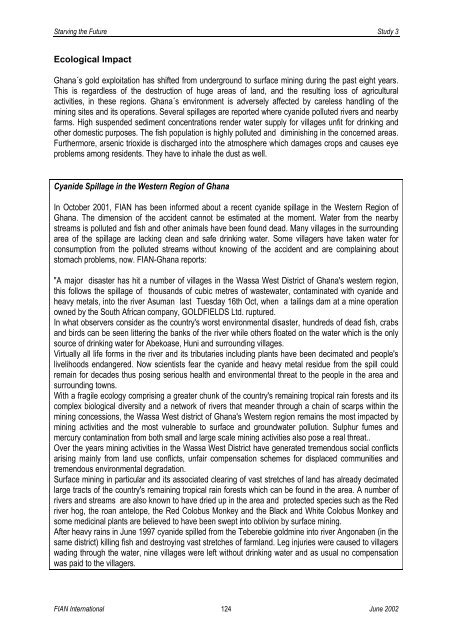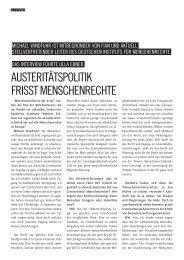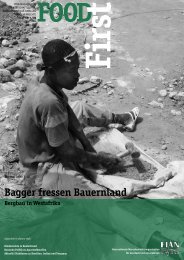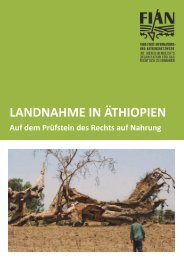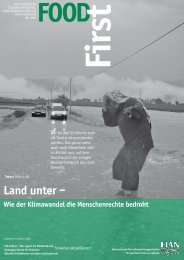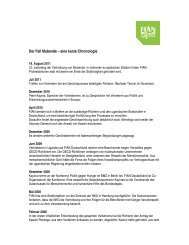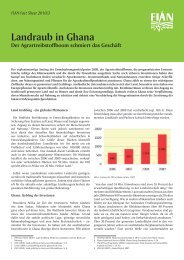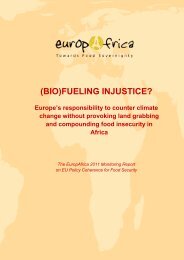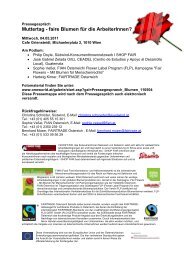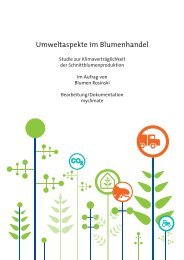Study 3: Ecodestruction and the Right to Food: The Cases of Water ...
Study 3: Ecodestruction and the Right to Food: The Cases of Water ...
Study 3: Ecodestruction and the Right to Food: The Cases of Water ...
Create successful ePaper yourself
Turn your PDF publications into a flip-book with our unique Google optimized e-Paper software.
Starving <strong>the</strong> Future <strong>Study</strong> 3<br />
Ecological Impact<br />
Ghana´s gold exploitation has shifted from underground <strong>to</strong> surface mining during <strong>the</strong> past eight years.<br />
This is regardless <strong>of</strong> <strong>the</strong> destruction <strong>of</strong> huge areas <strong>of</strong> l<strong>and</strong>, <strong>and</strong> <strong>the</strong> resulting loss <strong>of</strong> agricultural<br />
activities, in <strong>the</strong>se regions. Ghana´s environment is adversely affected by careless h<strong>and</strong>ling <strong>of</strong> <strong>the</strong><br />
mining sites <strong>and</strong> its operations. Several spillages are reported where cyanide polluted rivers <strong>and</strong> nearby<br />
farms. High suspended sediment concentrations render water supply for villages unfit for drinking <strong>and</strong><br />
o<strong>the</strong>r domestic purposes. <strong>The</strong> fish population is highly polluted <strong>and</strong> diminishing in <strong>the</strong> concerned areas.<br />
Fur<strong>the</strong>rmore, arsenic trioxide is discharged in<strong>to</strong> <strong>the</strong> atmosphere which damages crops <strong>and</strong> causes eye<br />
problems among residents. <strong>The</strong>y have <strong>to</strong> inhale <strong>the</strong> dust as well.<br />
Cyanide Spillage in <strong>the</strong> Western Region <strong>of</strong> Ghana<br />
In Oc<strong>to</strong>ber 2001, FIAN has been informed about a recent cyanide spillage in <strong>the</strong> Western Region <strong>of</strong><br />
Ghana. <strong>The</strong> dimension <strong>of</strong> <strong>the</strong> accident cannot be estimated at <strong>the</strong> moment. <strong>Water</strong> from <strong>the</strong> nearby<br />
streams is polluted <strong>and</strong> fish <strong>and</strong> o<strong>the</strong>r animals have been found dead. Many villages in <strong>the</strong> surrounding<br />
area <strong>of</strong> <strong>the</strong> spillage are lacking clean <strong>and</strong> safe drinking water. Some villagers have taken water for<br />
consumption from <strong>the</strong> polluted streams without knowing <strong>of</strong> <strong>the</strong> accident <strong>and</strong> are complaining about<br />
s<strong>to</strong>mach problems, now. FIAN-Ghana reports:<br />
"A major disaster has hit a number <strong>of</strong> villages in <strong>the</strong> Wassa West District <strong>of</strong> Ghana's western region,<br />
this follows <strong>the</strong> spillage <strong>of</strong> thous<strong>and</strong>s <strong>of</strong> cubic metres <strong>of</strong> wastewater, contaminated with cyanide <strong>and</strong><br />
heavy metals, in<strong>to</strong> <strong>the</strong> river Asuman last Tuesday 16th Oct, when a tailings dam at a mine operation<br />
owned by <strong>the</strong> South African company, GOLDFIELDS Ltd. ruptured.<br />
In what observers consider as <strong>the</strong> country's worst environmental disaster, hundreds <strong>of</strong> dead fish, crabs<br />
<strong>and</strong> birds can be seen littering <strong>the</strong> banks <strong>of</strong> <strong>the</strong> river while o<strong>the</strong>rs floated on <strong>the</strong> water which is <strong>the</strong> only<br />
source <strong>of</strong> drinking water for Abekoase, Huni <strong>and</strong> surrounding villages.<br />
Virtually all life forms in <strong>the</strong> river <strong>and</strong> its tributaries including plants have been decimated <strong>and</strong> people's<br />
livelihoods endangered. Now scientists fear <strong>the</strong> cyanide <strong>and</strong> heavy metal residue from <strong>the</strong> spill could<br />
remain for decades thus posing serious health <strong>and</strong> environmental threat <strong>to</strong> <strong>the</strong> people in <strong>the</strong> area <strong>and</strong><br />
surrounding <strong>to</strong>wns.<br />
With a fragile ecology comprising a greater chunk <strong>of</strong> <strong>the</strong> country's remaining tropical rain forests <strong>and</strong> its<br />
complex biological diversity <strong>and</strong> a network <strong>of</strong> rivers that me<strong>and</strong>er through a chain <strong>of</strong> scarps within <strong>the</strong><br />
mining concessions, <strong>the</strong> Wassa West district <strong>of</strong> Ghana's Western region remains <strong>the</strong> most impacted by<br />
mining activities <strong>and</strong> <strong>the</strong> most vulnerable <strong>to</strong> surface <strong>and</strong> groundwater pollution. Sulphur fumes <strong>and</strong><br />
mercury contamination from both small <strong>and</strong> large scale mining activities also pose a real threat..<br />
Over <strong>the</strong> years mining activities in <strong>the</strong> Wassa West District have generated tremendous social conflicts<br />
arising mainly from l<strong>and</strong> use conflicts, unfair compensation schemes for displaced communities <strong>and</strong><br />
tremendous environmental degradation.<br />
Surface mining in particular <strong>and</strong> its associated clearing <strong>of</strong> vast stretches <strong>of</strong> l<strong>and</strong> has already decimated<br />
large tracts <strong>of</strong> <strong>the</strong> country's remaining tropical rain forests which can be found in <strong>the</strong> area. A number <strong>of</strong><br />
rivers <strong>and</strong> streams are also known <strong>to</strong> have dried up in <strong>the</strong> area <strong>and</strong> protected species such as <strong>the</strong> Red<br />
river hog, <strong>the</strong> roan antelope, <strong>the</strong> Red Colobus Monkey <strong>and</strong> <strong>the</strong> Black <strong>and</strong> White Colobus Monkey <strong>and</strong><br />
some medicinal plants are believed <strong>to</strong> have been swept in<strong>to</strong> oblivion by surface mining.<br />
After heavy rains in June 1997 cyanide spilled from <strong>the</strong> Teberebie goldmine in<strong>to</strong> river Angonaben (in <strong>the</strong><br />
same district) killing fish <strong>and</strong> destroying vast stretches <strong>of</strong> farml<strong>and</strong>. Leg injuries were caused <strong>to</strong> villagers<br />
wading through <strong>the</strong> water, nine villages were left without drinking water <strong>and</strong> as usual no compensation<br />
was paid <strong>to</strong> <strong>the</strong> villagers.<br />
FIAN International 124<br />
June 2002


